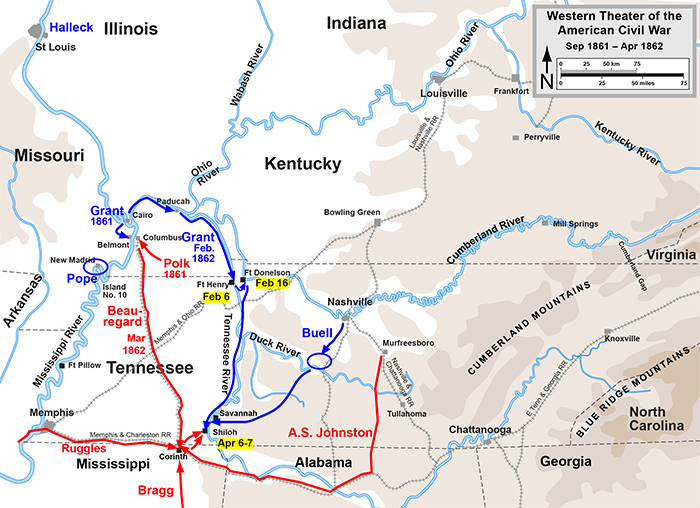The Battle of Fort Donelson
The Battle of Fort Donelson was a victory for the Union during the American Civil War. Seizure of the fort allowed Union troops to take control of the Cumberland River and paved the way for an invasion of Tennessee. 
After seizing Fort Henry relatively easily, Union troops under Brig. Gen. Ulysses S. Grant sped to that fort's twin, Fort Donelson, in order to capture it as well. Union commanders planned to capture Nashville, and taking both forts would make that task much easier. The commander at Fort Henry, Brig. Gen. Lloyd Tilghman, had moved most of the defending force to Fort Donelson. As well, Gen. Albert Sidney Johnston, the Confederate commander in the west, had sent reinforcements numbering 12,000 to Fort Donelson, where the commander was Brig. Gen. and former U.S. Secretary of War John B. Floyd. 
As at Fort Henry, Grant commanded a large contingent of land troops and Flag Officer Andrew Foote commanded a squadron of seven gunboats, four of them ironclads. Grant and his men marched 12 miles over frozen roads while Foote and his men and ships sailed from the Tennessee River to the Cumberland River. Arriving just in time was a contingent of reinforcements led by Brig. Gen. Lew Wallace. By the end of the day on February 13, 1862, Union troops numbering about 25,000 had surrounded the fort. A gunboat assault on February 14 did some damage, but the guns at Fort Donelson were heavier and more numerous than those at Fort Henry and so Foote called off the attack. 
Seeing the strength of the Union attackers, Floyd resolved to try to break out of the fort. His troops did so on the morning of February 15, making significant headway because Grant had that morning gone off to meet with his naval commander, Foote, and, having ordered his troops not to attack until he returned, had not designated a second-in-command. Union troops stopped the Confederate breakout attempt at 12:30 p.m., and Grant returned by 1 p.m. Brig. Gen. Gideon Pillow saw his chance to escape and ordered his men to take it, stopping to get more ammunition on the way out. However, Floyd countermanded that order by issuing a call to return to the fort. The fighting resumed. The defenders withstood a furious Union assault, and darkness ended the fighting. Under cover of darkness, a large number of the defenders, including their commanders Floyd and Pillow, left the fort, wading through the river shallows in order to avoid capture. Left in command was Brig. Gen. Simon Buckner. 
As dawn came on February 16, Buckner sent to the Union troops a message of surrender, with a suggestion that the two sides could negotiate the terms of that surrender. Grant's now-famous reply included this sentence: "No terms except unconditional and immediate surrender can be accepted." Buckner, in no position to survive an assault, complied, surrendering the fort and what was left of its defense force. Deaths on the Confederate side numbered 327; wounded were 1,127; the number captured was nearly 12,392. Similar figures for the Union were 507 dead, 1,976 wounded, and 208 captured or missing. In the end, the Battle of Fort Donelson was a resounding strategic victory for the Union. Captured in this battle and that at Fort Henry were almost a third of the available soldiers in the Confederate western theater. As well, the way to Nashville and the rest of Tennessee was open to further Union action. Grant, who had captured by this time more men than all other Union generals combined, was promoted to major general. |
|
Social Studies for Kids
copyright 2002–2025
David White




